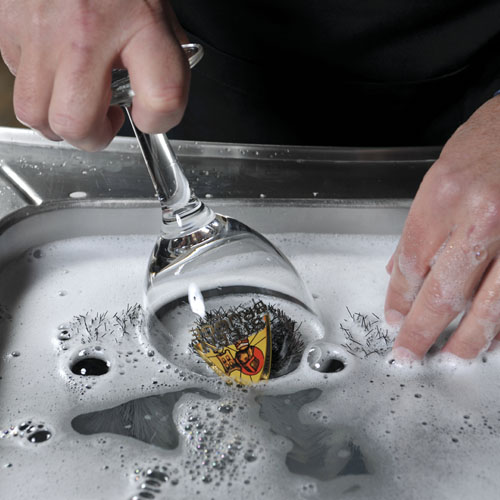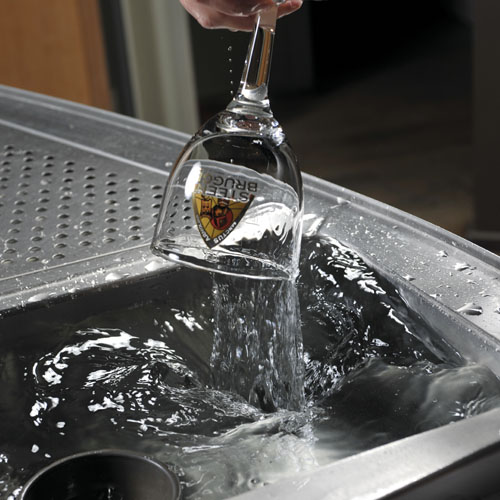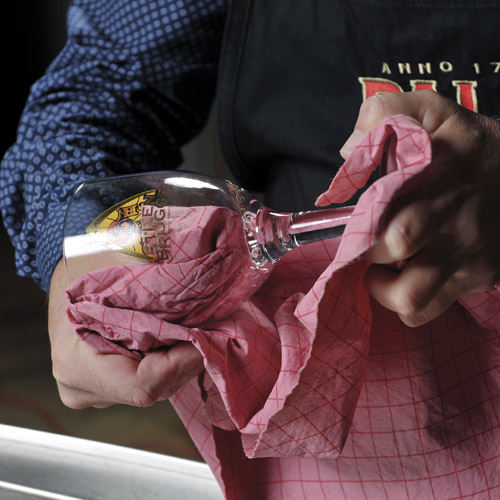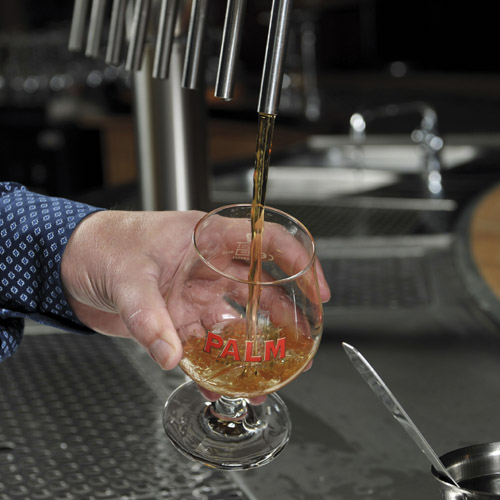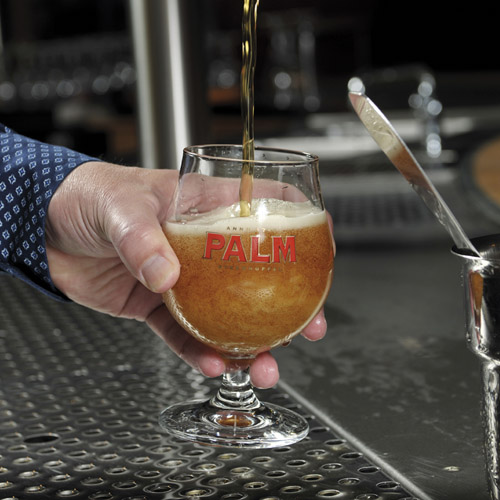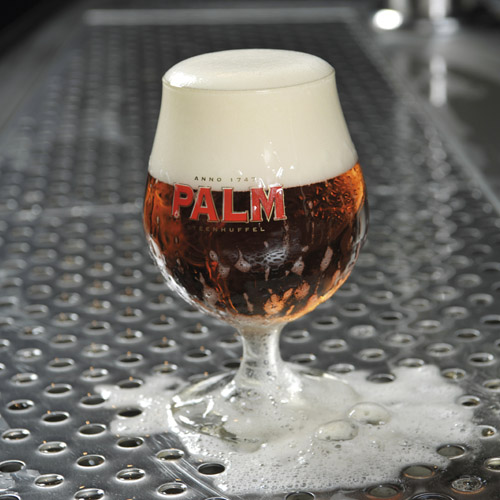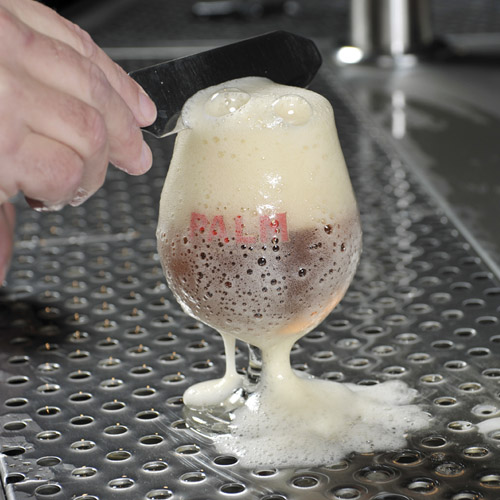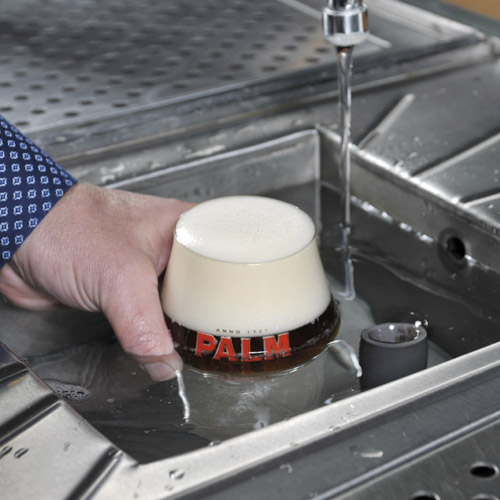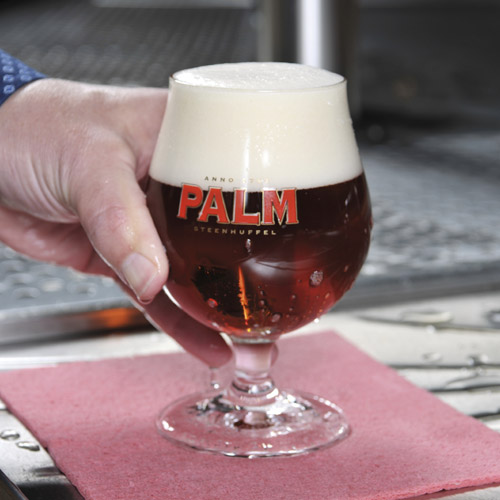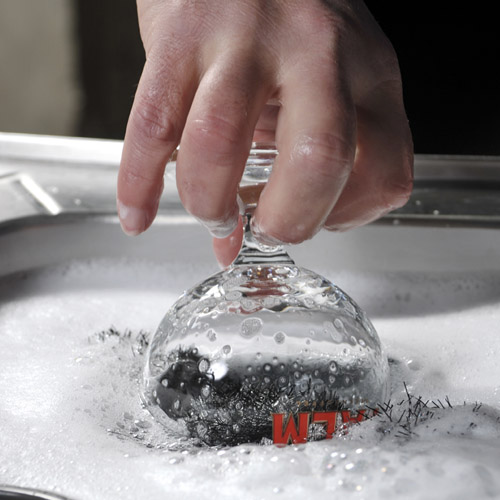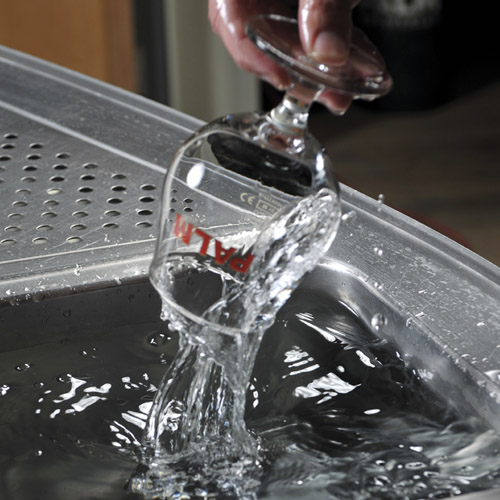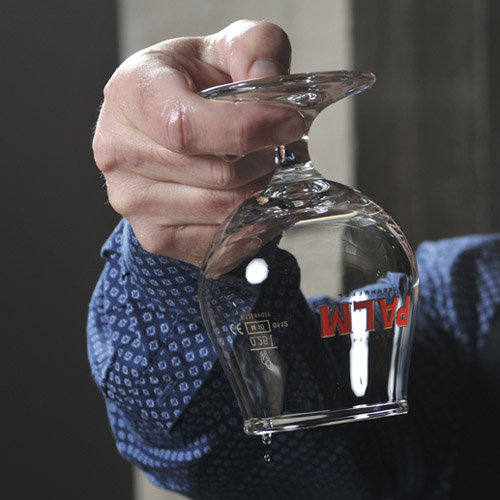
Drawing and serving
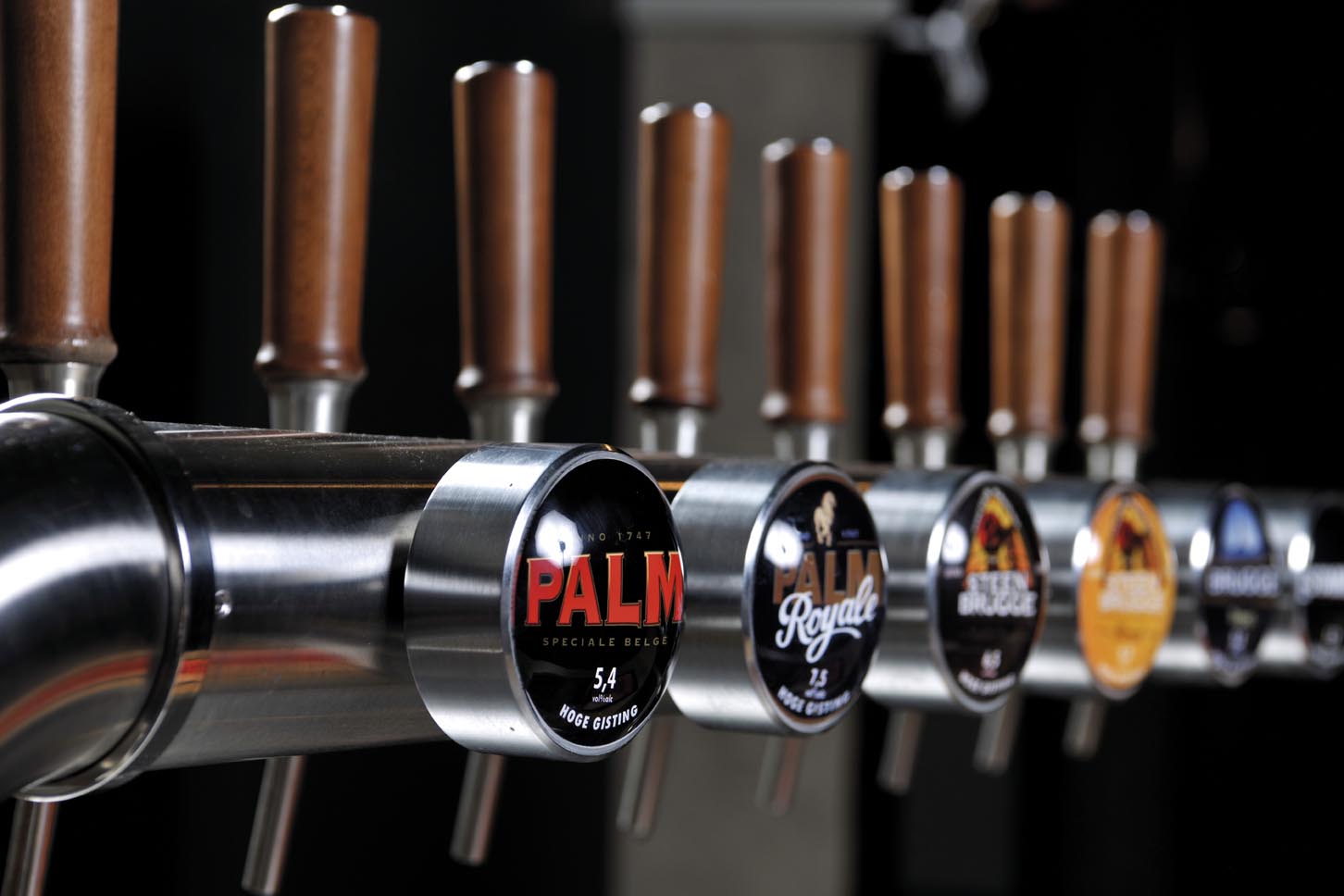
Pouring and serving

Preparing the glasses
Clean the glassware in a detergent solution (Becharein) using brushes.
Rinse off in a second sink with clean water. Fully submerge each glass with the opening facing up, so that the glass fills with water. Repeat two to three times.
Inspect the glasses immediately after rinsing. Hold up the glass toward the light, with the opening facing down. Repeat steps 1 and 2 if the water film opens around any remaining greasy spots.
Do not dry glasses for draught beers. Place them on a clean drainer with the opening facing up for immediate use. Glasses which you’re not going to use immediately should be placed with the opening facing down. Never put a cloth under the glasses.
Drawing
Before drawing, moisten the glass under the glass sprayer (best fed with chilled water).
Open the draught tower completely and let the first burst of foam drop next to the glass.
Bring the glass at a 45° angle under the draft tower and let the stream of beer flow down the side of the tilted glass.
Hold the glass directly under the stream of beer once it is 1/3 to 1/2 full. with the base resting on the drainer.
Shut off the tap when the foam runs over the glass. Place the full glass beside the tap on the drainer to avoid any drips falling from the tap.
With a single sweep, remove the coarse foam bubbles with a clean skimming blade.
Dip the glass in water to remove any foam and beer residue from the outside and base.
Wipe the base of the glass on a terry cloth.
Never top up the glass. Apart from a few special drawing practices for certain beers, always fill a beer glass in one go. Topping up the glass adds carbon dioxide gas. This displaces the natural carbon dioxide gas in the beer, and the beer becomes flatter and less digestible.
Serving
Hold the glass at the bottom and serve it, preferably on a beer mat, with the brand name facing the customer.
Bottom-fermentation beers and top-fermentation smooth drinking beers which are served cold (Spéciale Belge, white beer, Old Brown, Flanders Red-Brown) are dispensed in cold glasses. Other top-fermentation beers and spontaneous-fermentation beers are best served at 6-8°C and dispensed in dry or chilled glasses, according to brewery recommendations.
Preparing the glasses
Clean the glassware in a detergent solution (Becharein) using brushes.
Rinse off in a second sink with clean water. Fully submerge each glass with the opening facing up, so that the glass fills with water. Repeat two to three times.
Inspect the glasses immediately after rinsing. Hold up the glass toward the light, with the opening facing down. Repeat steps 1 and 2 if the water film opens around any remaining greasy spots.
Place the glasses on a clean drainer with the opening facing up for immediate use. Glasses which you’re not going to use immediately should be placed with the opening facing down. Never put a cloth under the glasses.
Pouring and serving smooth drinking beers
- STEP 1: Chill the glass and let it drain.
- STEP 2: Take the bottle from the refrigerator and uncork it.
- STEP 3: Let the beer run into the tilted glass (45°) slowly and without any glugging. Ensure that the bottle neck doesn’t touch the foam or the glass.
- STEP 4: Slowly straighten up the glass and adjust the distance between the glass and the bottle to form the desired head and fill the glass nicely. When the bottle is empty, the foam should overflow the glass.
- STEP 5: With a single sweep, remove the coarse foam bubbles with a clean skimming blade.
- STEP 6: Dip the glass in water to remove any foam and beer residue from the outside and base.
- STEP 7: Wipe the base of the glass on a terry cloth.
- STEP 8: Hold the glass at the bottom and serve it, preferably on a beer mat, with the brand name facing the customer.
Pouring and serving connoisseurs’ beers (not re-fermented) at the table
- STEP 1: Chill the glass, let it drain, and then dry it with a clean, synthetic chamois.
- STEP 2: Take the bottle from the refrigerator.
- STEP 3: Uncork the bottle, preferable in the presence of the customer.
- STEP 4: Let the beer run into the tilted glass (45°) slowly and without any glugging. Ensure that the bottle neck doesn’t touch the foam or the glass.
- STEP 5: Slowly straighten up the glass and adjust the distance between the glass and the bottle to form the desired head and fill the glass nicely.
- STEP 6: Present the glass with the brand name facing the customer at the table and place the bottle next to it.
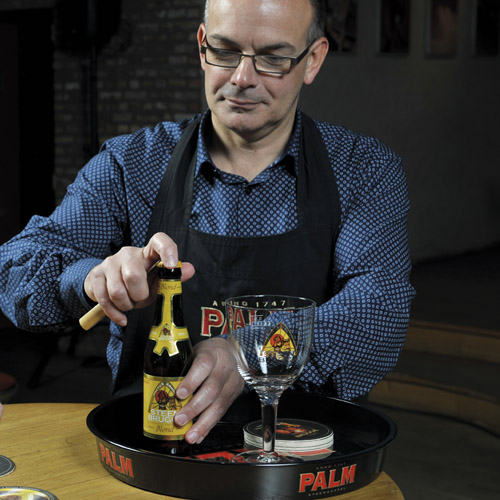
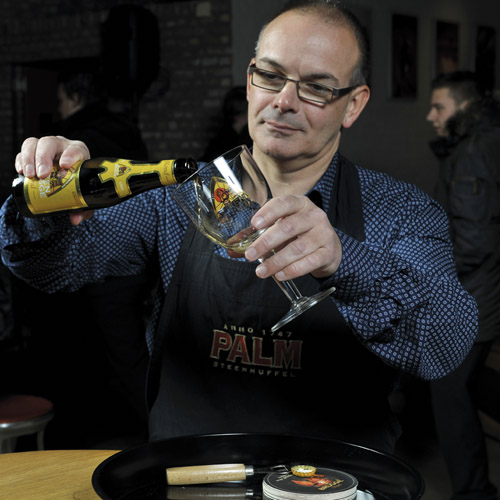
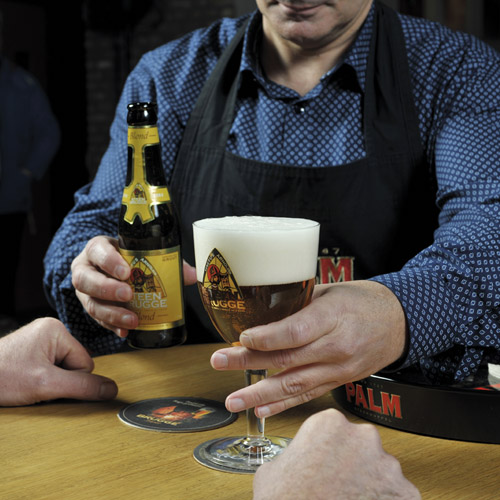
Pouring and serving re-fermented connoisseurs’ beers
- STEP 1: Dry the glass with a clean, synthetic chamois.
- STEP 2: Take the bottle from the refrigerator.
- STEP 3: Take the still unopened bottle, the clean glass, two beer mats and a bottle opener with you to the customer’s table. Ask the customer if they prefer to have the beer poured clear or turbid (with lees).
- STEP 4 A: If the customer prefers a clear beer, leave around one centimetre of beer, with the “sediment”, in the bottle. Pour the beer into a tilted glass. Slowly straighten up the glass and adjust the distance between the glass and the bottle to form the desired head and fill the glass nicely.
- STEP 4 B: If the customer prefers beer with lees, pour the entire content of the bottle. Pour two-thirds of the beer along the side of a tilted glass. Then gently swirl the bottle briefly to loosen the lees. Slowly straighten up the glass and adjust the distance between the glass and bottle to form the desired head.
- STEP 4 C: If the customer prefers both options (clear and turbid), pour two-thirds of the bottle with clear beer and then place the bottle next to the glass, so that the customer can top up the glass with the remaining beer containing the lees.
- STEP 5: Always fill the glass slowly, without any glugging or gushing, in one smooth motion. Glugging hampers the formation of a stable head, pushes the natural carbon dioxide gas out of the beer, and stirs up the sediment (yeast sediment that causes turbidity and extra bitterness).
- STEP 6: Place the glass and bottle on a beer mat, with the brand name facing the customer. Small champagne bottles (37.5 cl) should preferably be placed on the table in a wicker basket.

